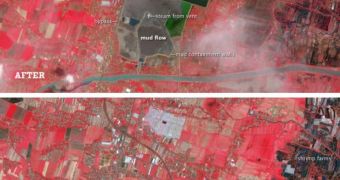On the morning of May 29, 2006, at around 5 am, the inhabitants of the area around Sidoarjo, in Indonesia, started noticing a mud volcano erupting nearby. This was the first day of the nightmare that was yet to come. Starting that day, the volcano has spewed around 100,000 tons of mud, or the equivalent of 60 Olympic-size swimming pools, each day. Locals accused a gas drilling company of starting the devastation, and now scientists appear to agree with the original assumptions. While the private company defended itself fiercely, it would now appear that it was indeed responsible for covering an area of three square miles with more than 65 feet of mud.
In the end, the Lusi volcano displaced around 30,000 people from their homes, and destroyed houses and businesses wherever it could. The mud is now being kept in place via massive blocks. Scientists have now been able to conclude that the damages should be paid by the company. “The disaster was caused by pulling the drill string and drill bit out of the hole while the hole was unstable. This triggered a very large ‘kick’ in the well, where there is a large influx of water and gas from surrounding rock formations that could not be controlled,” the Director of the Durham Energy Institute, Richard Daviesand, says in a press release.
He is also a coauthor of the new investigation, details of which appear in the latest issue of the respected scientific journal Marine and Petroleum Geology. While shifting through the logs kept by Lapindo Brantas, the company in question, experts were able to find evidence that the engineers working for the gas exploitation tried to mitigate the situation by pouring drilling mud into the hole, so as to stop the mud coming up. “This was partially successful, and the eruption of the mud volcano slowed down. The fact that the eruption slowed provides the first conclusive evidence that the bore hole was connected to the volcano at the time of eruption,” Davies argues.
The new paper came as a response to another one, published by the company's lead driller, in the same journal. It stated that the firm was obviously not responsible for the damage, and that an earthquake that had occurred a few days before, and some 150 kilometers away was to blame. However, the author of the paper that study cited as a source stepped into the controversy and said that his work could not be used to support such an argument, Wired reports.

 14 DAY TRIAL //
14 DAY TRIAL //